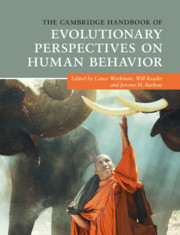Book contents
- The Cambridge Handbook of Evolutionary Perspectives on Human Behavior
- The Cambridge Handbook of Evolutionary Perspectives on Human Behavior
- Copyright page
- Dedication
- Contents
- Figures
- Tables
- Contributors
- Preface
- Acknowledgments
- Part I The Comparative Approach
- Part II Sociocultural Anthropology and Evolution
- Part III Evolution and Neuroscience
- Part IV Group Living
- Part V Evolution and Cognition
- Part VI Evolution and Development
- Part VII Sexual Selection and Human Sex Differences
- Part VIII Abnormal Behavior and Evolutionary Psychopathology
- 32 Psychopathology from an Evolutionary Perspective
- 33 Are We on the Verge of Darwinian Psychiatry?
- 34 The Evolution of Pro-social Behavior
- 35 Disordered Social Cognition
- Part IX Applying Evolutionary Principles
- Part X Evolution and the Media
- Index
- References
34 - The Evolution of Pro-social Behavior
From Caring to Compassion
from Part VIII - Abnormal Behavior and Evolutionary Psychopathology
Published online by Cambridge University Press: 02 March 2020
- The Cambridge Handbook of Evolutionary Perspectives on Human Behavior
- The Cambridge Handbook of Evolutionary Perspectives on Human Behavior
- Copyright page
- Dedication
- Contents
- Figures
- Tables
- Contributors
- Preface
- Acknowledgments
- Part I The Comparative Approach
- Part II Sociocultural Anthropology and Evolution
- Part III Evolution and Neuroscience
- Part IV Group Living
- Part V Evolution and Cognition
- Part VI Evolution and Development
- Part VII Sexual Selection and Human Sex Differences
- Part VIII Abnormal Behavior and Evolutionary Psychopathology
- 32 Psychopathology from an Evolutionary Perspective
- 33 Are We on the Verge of Darwinian Psychiatry?
- 34 The Evolution of Pro-social Behavior
- 35 Disordered Social Cognition
- Part IX Applying Evolutionary Principles
- Part X Evolution and the Media
- Index
- References
Summary
Some of the roots of pro-social behavior, of which caring and compassion are forms, are from the evolution of parental investment and caring (Brown & Brown, 2015; Fogel, Melson, & Mistry, 1986; Gilbert, 1989/2016, 2009; Mayseless, 2016; Preston, 2013; Seppälä, Simon-Thomas, Brown, Worline, Cameron, & Doty. (2017)). There are a number of different dictionary definitions of caring. A typical one is “the provision of what is needed for the well-being or protection of a person or thing” (www.dictionary.com/browse/caring). Fogel, Melson, and Mistry (1986) suggested that the core elements of care-nurturance are “The provision of guidance, protection and care for the purpose of fostering developmental change congruent with the expected potential for change of the object of nurturance” (p. 55).
- Type
- Chapter
- Information
- Publisher: Cambridge University PressPrint publication year: 2020
References
- 2
- Cited by



